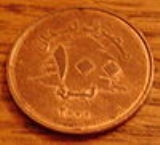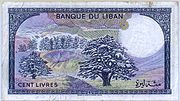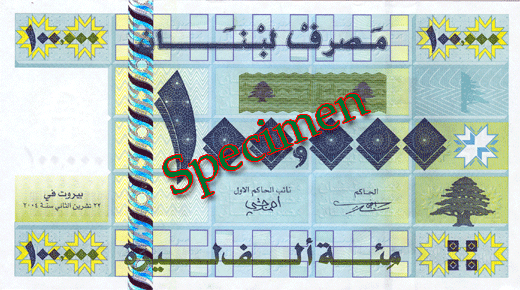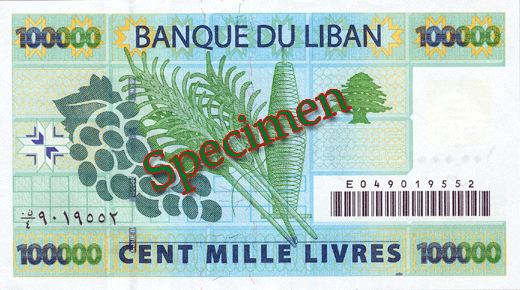
Lebanese pound
Encyclopedia
The Lebanese pound is the currency unit of Lebanon
. It is divided into 100 piastres but inflation
has eliminated the subdivisions.
The plural
form of lira, as used on the currency, is either lirat (ليرات) or the same, whilst there are four forms for qirsh: the dual qirshan (قرشان), the plural qirush (قروش) used with numbers 3-10, the accusative singular qirsha (قرشا) used with 11-99, or the genitive singular qirshi (قرش) used with multiples of 100. In both cases, the number determines which plural form is used. Note that before the Second World War, the Arabic spelling of the subdivision was غرش (girsh). All of Lebanon's coins and banknotes are bilingual in Arabic and French.
, the Ottoman
lira
was used. After the fall of the Ottoman Empire, the currency became the Egyptian pound
in 1918. Upon gaining control of Syria
and Lebanon, the French
replaced the Egyptian pound with a new currency for Syria and Lebanon, the Syrian pound
, which was linked to the French franc
at a value of 1 pound = 20 francs. Lebanon issued its own coins from 1924 and banknotes from 1925. In 1939, the Lebanese currency was officially separated from that of Syria, though it was still linked to the French franc and remained interchangeable with Syrian money. In 1941, following France's defeat by Nazi Germany
, the currency was linked instead to the British pound sterling
at a rate of 8.83 Lebanese pounds = 1 pound sterling. A link to the French franc was restored after the war but was abandoned in 1949.
Before the war of 1975-1990, 1 U.S. dollar
was worth 3 pounds. According to the central bank's data, 1 U.S. dollar
has been equal to 1507.5 pounds for the entire year of 2006.
coins) with the French denominations given in "piastres syriennes" (Syrian piastres). Later issues did not include the word "syriennes" and were in denominations of ½, 1, 2, 2½, 5, 10, 25 and 50 girsha. During World War II, rather crude ½, 1 and 2½ girsh coins were issued.
After the war, the Arabic spelling was changed from girsh (غرش) to qirsh (قرش). Coins were issued in the period 1952 to 1986 in denominations of 1, 2½, 5, 10, 25 and 50 qirsh and 1 lira. No coins were issued between 1986 and 1996, when the current series of coins was introduced. Coins in current use are:
 Lebanon's first banknotes were issued by the Bank of Syria and Greater Lebanon (Banque du Syrie et Grand-Liban) in 1925. Denominations ran from 25 girsha through to 100 pounds. In 1939, the bank's name was changed to the Bank of Syria and Lebanon. The first 250 pound notes appeared that year. Between 1942 and 1950, the government issued "small change" paper money in denominations of 5, 10, 25 and 50 girsh or qirsh (the change in spelling occurred during these years). After 1945, the Bank of Syria and Lebanon continued to issue paper money for Lebanon but the notes were denominated specifically in "Lebanese pounds" (ليرة لبنانية, livre libanaise) to distinguish them from Syrian notes. Notes for 1, 5, 10, 25, 50 and 100 pounds were issued. In 1964, the Bank of Lebanon took over banknote production. Their notes are denominated in pounds. A 250 pound note reappeared in 1978, followed by higher denominations in the 1980s and 1990s as inflation drastically reduced the currency's value. Banknote
Lebanon's first banknotes were issued by the Bank of Syria and Greater Lebanon (Banque du Syrie et Grand-Liban) in 1925. Denominations ran from 25 girsha through to 100 pounds. In 1939, the bank's name was changed to the Bank of Syria and Lebanon. The first 250 pound notes appeared that year. Between 1942 and 1950, the government issued "small change" paper money in denominations of 5, 10, 25 and 50 girsh or qirsh (the change in spelling occurred during these years). After 1945, the Bank of Syria and Lebanon continued to issue paper money for Lebanon but the notes were denominated specifically in "Lebanese pounds" (ليرة لبنانية, livre libanaise) to distinguish them from Syrian notes. Notes for 1, 5, 10, 25, 50 and 100 pounds were issued. In 1964, the Bank of Lebanon took over banknote production. Their notes are denominated in pounds. A 250 pound note reappeared in 1978, followed by higher denominations in the 1980s and 1990s as inflation drastically reduced the currency's value. Banknote
s in current use are:
All current notes feature an Arabic side with the value in Arabic script numerals of large size. The other side is in French with the serial number in both Arabic and Latin script and in bar code below the latter one.
Lebanon
Lebanon , officially the Republic of LebanonRepublic of Lebanon is the most common term used by Lebanese government agencies. The term Lebanese Republic, a literal translation of the official Arabic and French names that is not used in today's world. Arabic is the most common language spoken among...
. It is divided into 100 piastres but inflation
Inflation
In economics, inflation is a rise in the general level of prices of goods and services in an economy over a period of time.When the general price level rises, each unit of currency buys fewer goods and services. Consequently, inflation also reflects an erosion in the purchasing power of money – a...
has eliminated the subdivisions.
The plural
Plural
In linguistics, plurality or [a] plural is a concept of quantity representing a value of more-than-one. Typically applied to nouns, a plural word or marker is used to distinguish a value other than the default quantity of a noun, which is typically one...
form of lira, as used on the currency, is either lirat (ليرات) or the same, whilst there are four forms for qirsh: the dual qirshan (قرشان), the plural qirush (قروش) used with numbers 3-10, the accusative singular qirsha (قرشا) used with 11-99, or the genitive singular qirshi (قرش) used with multiples of 100. In both cases, the number determines which plural form is used. Note that before the Second World War, the Arabic spelling of the subdivision was غرش (girsh). All of Lebanon's coins and banknotes are bilingual in Arabic and French.
History
Before World War IWorld War I
World War I , which was predominantly called the World War or the Great War from its occurrence until 1939, and the First World War or World War I thereafter, was a major war centred in Europe that began on 28 July 1914 and lasted until 11 November 1918...
, the Ottoman
Ottoman Empire
The Ottoman EmpireIt was usually referred to as the "Ottoman Empire", the "Turkish Empire", the "Ottoman Caliphate" or more commonly "Turkey" by its contemporaries...
lira
Turkish lira
The Turkish lira is the currency of Turkey and the de facto independent state of the Turkish Republic of Northern Cyprus. The lira is subdivided into 100 kuruş...
was used. After the fall of the Ottoman Empire, the currency became the Egyptian pound
Egyptian pound
The Egyptian Pound is the currency of Egypt. It is divided into 100 Qirsh , or 1,000 Milliemes ....
in 1918. Upon gaining control of Syria
Syria
Syria , officially the Syrian Arab Republic , is a country in Western Asia, bordering Lebanon and the Mediterranean Sea to the West, Turkey to the north, Iraq to the east, Jordan to the south, and Israel to the southwest....
and Lebanon, the French
France
The French Republic , The French Republic , The French Republic , (commonly known as France , is a unitary semi-presidential republic in Western Europe with several overseas territories and islands located on other continents and in the Indian, Pacific, and Atlantic oceans. Metropolitan France...
replaced the Egyptian pound with a new currency for Syria and Lebanon, the Syrian pound
Syrian pound
-Use of 10 Syrian pound coins in Norway:The shape of the 10 Syrian pound coin has been found to so resemble the 20 Norwegian krone coin that it can fool vending machines, coins-to-cash machines, arcade machines, and any other coin-operated, automated service machine in the country...
, which was linked to the French franc
French franc
The franc was a currency of France. Along with the Spanish peseta, it was also a de facto currency used in Andorra . Between 1360 and 1641, it was the name of coins worth 1 livre tournois and it remained in common parlance as a term for this amount of money...
at a value of 1 pound = 20 francs. Lebanon issued its own coins from 1924 and banknotes from 1925. In 1939, the Lebanese currency was officially separated from that of Syria, though it was still linked to the French franc and remained interchangeable with Syrian money. In 1941, following France's defeat by Nazi Germany
Nazi Germany
Nazi Germany , also known as the Third Reich , but officially called German Reich from 1933 to 1943 and Greater German Reich from 26 June 1943 onward, is the name commonly used to refer to the state of Germany from 1933 to 1945, when it was a totalitarian dictatorship ruled by...
, the currency was linked instead to the British pound sterling
Pound sterling
The pound sterling , commonly called the pound, is the official currency of the United Kingdom, its Crown Dependencies and the British Overseas Territories of South Georgia and the South Sandwich Islands, British Antarctic Territory and Tristan da Cunha. It is subdivided into 100 pence...
at a rate of 8.83 Lebanese pounds = 1 pound sterling. A link to the French franc was restored after the war but was abandoned in 1949.
Before the war of 1975-1990, 1 U.S. dollar
United States dollar
The United States dollar , also referred to as the American dollar, is the official currency of the United States of America. It is divided into 100 smaller units called cents or pennies....
was worth 3 pounds. According to the central bank's data, 1 U.S. dollar
United States dollar
The United States dollar , also referred to as the American dollar, is the official currency of the United States of America. It is divided into 100 smaller units called cents or pennies....
has been equal to 1507.5 pounds for the entire year of 2006.
Coins
Lebanon's first coins were issued in 1924 in denominations of 2 and 5 girush (note the different spelling to post WWIIWorld War II
World War II, or the Second World War , was a global conflict lasting from 1939 to 1945, involving most of the world's nations—including all of the great powers—eventually forming two opposing military alliances: the Allies and the Axis...
coins) with the French denominations given in "piastres syriennes" (Syrian piastres). Later issues did not include the word "syriennes" and were in denominations of ½, 1, 2, 2½, 5, 10, 25 and 50 girsha. During World War II, rather crude ½, 1 and 2½ girsh coins were issued.
After the war, the Arabic spelling was changed from girsh (غرش) to qirsh (قرش). Coins were issued in the period 1952 to 1986 in denominations of 1, 2½, 5, 10, 25 and 50 qirsh and 1 lira. No coins were issued between 1986 and 1996, when the current series of coins was introduced. Coins in current use are:
- 50 pounds (Not in use anymore)
- 100 pounds (Not in use anymore)
- 250 pounds
- 500 pounds
| Current series | ||||
|---|---|---|---|---|
| Image | Value | Metal | | | |
| Obverse | Reverse | |||
| 50 pounds | Stainless Steel Stainless steel In metallurgy, stainless steel, also known as inox steel or inox from French "inoxydable", is defined as a steel alloy with a minimum of 10.5 or 11% chromium content by mass.... |
White | ||
 |
 |
100 pounds | Copper - Zinc | red copper |
| 100 pounds (2003 Issue) |
Nickel | white | ||
| 250 pounds | Bronze - Aluminum | golden yellow | ||
| 500 pounds | Nickel - Acier | white | ||
Banknotes

Banknote
A banknote is a kind of negotiable instrument, a promissory note made by a bank payable to the bearer on demand, used as money, and in many jurisdictions is legal tender. In addition to coins, banknotes make up the cash or bearer forms of all modern fiat money...
s in current use are:
| Current series | |||
|---|---|---|---|
| Image | Value | Main Colour | |
| Obverse | Reverse | ||
 |
 |
1,000 pounds | Green |
 |
 |
5,000 pounds | Pink |
 |
 |
10,000 pounds | Yellow |
 |
 |
20,000 pounds | Red |
 |
 |
50,000 pounds | Purple |
 |
 |
100,000 pounds | Blue |
All current notes feature an Arabic side with the value in Arabic script numerals of large size. The other side is in French with the serial number in both Arabic and Latin script and in bar code below the latter one.

